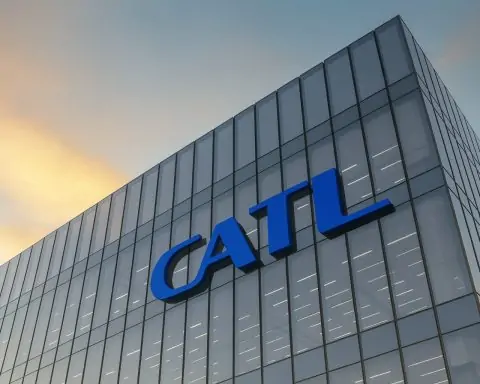- Bitcoin briefly surged to $120,000 before pulling back about 2%, triggering over 176,000 liquidations and more than $500 million in losses.
- Analysts see a potential local bottom near $113,000 as a Fibonacci level, with a path to new highs above $130,000 after this consolidation.
- Ether (ETH) nearly touched $3,860 on Monday before profit-taking to about $3,745, and is up roughly 67% in the past month.
- SharpLink Gaming now holds 360,807 ETH, surpassing BitMine Immersion’s 300,657 ETH to become the largest public Ether holder.
- Solana (SOL) briefly traded above $200, up about 20% for the week and 47% over the past month, while Upexi Inc. raised $200 million to boost its SOL treasury to 1.818 million SOL (~$331 million) with an estimated $26 million in annual yield.
- Binance Coin (BNB) surged to an all-time high of $804, while Nano Labs accumulated 120,000 BNB (~$90 million) as a strategic reserve and aims to raise $500 million to buy up to 10% of total supply.
- The total crypto market cap rose above $4 trillion for the first time this cycle, and open interest on major alt futures surpassed $40 billion, signaling rising leverage.
- The Ozzy Osbourne death on July 22 sparked a CryptoBatz NFT frenzy, with floor prices around 0.08 ETH and 24-hour volume topping $281,000, while CryptoPunks weekly sales jumped 467% to about $22.2 million and the PENGU token rose over 500% in a month.
- In U.S. regulation, the GENIUS Act was signed on July 18 to create a federal framework for dollar-backed stablecoins, and the Digital Market Clarity Act passed the House on July 17 clarifying crypto asset definitions and enforcement.
- CoinShares became the first continental European asset manager to secure a MiCA license from France’s AMF, enabling passporting across all 27 EU countries.
Bitcoin Rally Stalls at $120K 📈
Bitcoin (BTC) briefly blasted up to the $120,000 mark – heights unseen in years – before pulling back ~2% mid-week [1]. The quick dip to around $117,500 on Wednesday triggered a wave of liquidations: over 176,000 traders saw positions wiped out, totaling >$500 million in losses [2]. Market veterans framed it as a healthy breather rather than a true breakout. “Not an actual breakout upwards… likely we’re going to retest the lows of the range again,” noted trader Michaël van de Poppe after BTC’s liquidity grab [3]. Analysts are eyeing support near $113K (a key Fibonacci retracement) as a potential local bottom – roughly a 6–7% pullback from the top [4]. Despite this volatility, Bitcoin’s uptrend remains intact on higher timeframes. Optimistic bulls still target fresh highs above $130K once the current consolidation passes [5]. Caution is creeping in, however, as open interest across crypto derivatives hit all-time highs, prompting on-chain firm Glassnode to warn of “froth” building in the market. Elevated leverage “tends to amplify both upside and downside volatility” and can leave the market “fragile,” Glassnode observed [6] [7] – a reminder for traders to manage risk even as sentiment runs hot.
Altcoin Season Resumes: ETH, XRP, SOL Soar 🚀
A broad altcoin rally is accompanying Bitcoin’s surge, reviving chatter of a new “altseason.” Ether (ETH) nearly touched $3,860 on Monday before profit-taking knocked it back to ~$3,745 [8]. Even after the dip, ETH is up about 67% in the past month [9]. Notably, two public companies have been on an ETH buying spree. BitMine Immersion now holds 300,657 ETH, but SharpLink Gaming just overtook it with 360,807 ETH after recent purchases [10] – making SharpLink the largest public Ether holder, a strategy reminiscent of MicroStrategy’s Bitcoin treasury playbook. Many bulls hope such accumulation will help push ETH back above $4,000 soon, though charts show ~$3,494 as a key support level; a break below that could open a slide into the mid-$3,300s [11] [12].
Other majors are on fire too. Ripple’s XRP leapt to a new all-time high around $3.65 on July 18 [13], buoyed by positive developments like the launch of a leveraged XRP ETF and recent legal wins clarifying XRP’s status. Although it has cooled slightly (trading near $3.50 now), analysts still see $3.80, $4.33, and $4.72 as upside targets in the near term [14]. Even meme and utility coins joined the party – Dogecoin (DOGE) is up ~35% this week, and Cardano (ADA) has surged 50% over the past two weeks [15]. Both remain well below their historic peaks, but their revival underscores a broad-based risk appetite. High-flying Solana (SOL) has been another standout. SOL briefly traded above $200 (roughly +20% for the week) and is up 47% over the past month [16] [17]. A major catalyst was institutional accumulation: Nasdaq-listed Upexi Inc. raised $200 million to boost its Solana treasury to 1.818 million SOL ($331M worth) [18] [19]. Upexi now stakes nearly all its SOL, expecting $26M in annual yield [20]. The company’s CEO touted this as a “first-of-its-kind” model for holding altcoins on a public company balance sheet, giving investors exposure to SOL’s upside [21] [22]. On the heels of this news, popular analysts on X (Twitter) proclaimed Solana “ready for a massive pump,” with some calling for $400–$500 per SOL in this cycle [23] [24]. Meanwhile Binance Coin (BNB) – the exchange token – made headlines by smashing through $800 to hit a new all-time high ($804) [25]. BNB is now up over 30% in the past month [26], briefly leapfrogging SOL by market cap. Binance founder CZ celebrated the milestone, thanking “BTC maxis, ETH holders, meme traders, ETF applicants, … good regulators, and utility builders” for contributing to BNB’s rise [27]. Behind the scenes, real demand is driving BNB: Nasdaq-listed Nano Labs revealed it accumulated 120,000 BNB ($90M worth) as a strategic reserve [28], and even plans to raise $500M to buy up to 10% of BNB’s total supply [29]. The message is clear – institutional treasuries are no longer just Bitcoin-only, as large players branch into top altcoins [30].
Overall, the altcoin resurgence has lifted the total crypto market cap above $4 trillion for the first time this cycle [31]. Derivatives data show speculative fervor rising: open interest on major altcoin futures has hit record highs (>$40B across top alts), reflecting a build-up of leverage [32] [33]. While this leverage is powering rapid gains, analysts caution it could amplify volatility on the way down [34]. For now, though, traders are reveling in the “risk-on” alt environment, rotating profits from Bitcoin into higher-beta coins. As one observer noted, this has been “probably the most discreet [altcoin] ATH … based on solid fundamentals rather than speculation,” contrasting with Bitcoin’s spotlight [35]. The question is how long the party can last before a cooling-off – but for the moment, crypto markets are knocking on the door of euphoria.
DeFi and Layer-2: Stability Amid Growth 🔗
Notably, the past 48 hours saw no major DeFi exploits or failures – a welcome respite in a year where hacks have already cost over $2 billion in crypto losses [36]. (For context, cross-chain bridges alone accounted for about 38% of all exploited value in H1 2025.) As crypto prices climb, decentralized finance activity is ticking up too: total value locked (TVL) in DeFi protocols has been rising alongside the market. Developers continue to roll out improvements. For example, on July 23 a Singapore-based firm launched a high-speed MEV trading bot offering sub-30 millisecond access to mempools and private relays [37] [38] – aiming to give traders an edge in capturing arbitrage and liquidation opportunities. This kind of Layer-2 infrastructure push shows how projects are racing to improve speed and efficiency for DeFi users. Ethereum’s major Layer-2 networks (Arbitrum, Optimism, Base, etc.) also maintain strong usage thanks to much lower fees than Ethereum mainnet, even if there were no blockbuster L2-specific news events in the past two days. The broader theme is one of building quietly: teams are focused on refining user experience and throughput in preparation for the next wave of users.
On the stablecoin lending front, growth continues, albeit with caution. No new DeFi rug-pulls were reported during this period, but security experts remain vigilant. Analyses of recent exploits suggest many could have been prevented with better input validation, oracle checks, and edge-case testing [39]. The community is urging protocols to undergo more rigorous audits to shore up confidence. In a positive sign, some platforms that suffered hacks earlier are seeing users return. For instance, Curve Resupply, a stablecoin yield project that lost ~$9.3M in a June exploit, reports that users have been coming back after the team patched the vulnerability and improved safeguards [40] [41]. Cross-chain bridges – which have historically been a prime target for attackers – also operated without incident this week, a relief given their troubled track record. (Bridges represented roughly one-third of crypto exploit losses in the first half of 2025.) All told, the lack of DeFi drama over the past two days underscores a sector that is maturing and prioritizing security and consolidation over unsustainable yield-hunting. As one industry insider put it, the focus now is on “making DeFi boring” – in a good way – by hardening the infrastructure so it can safely support the next growth phase.
NFTs and Memecoins: Mania Reignites 🎨🐕
After a prolonged slump, the NFT market flashed hints of its old frenzy this week – driven by both genuine fan interest and speculative hype. The catalyst was sadly unique: the surprise death of rock legend Ozzy Osbourne on July 22. Within hours of the news, fans and opportunists piled into Osbourne’s official CryptoBatz NFT collection, sending its metrics skyward. The floor price rocketed over 400% (from under 0.02 ETH to 0.08 ETH at peak) [42]. By Tuesday night, the cheapest “CryptoBat” was around 0.08 ETH ($295), up from ~$60 earlier that day [43]. Trading volume exploded by 100,000% in 24 hours, topping $281,000 according to DappRadar [44]. While these absolute numbers are modest compared to the 2021 NFT mania, the posthumous pump signals that collectors still crave cultural icons in digital form. “Though modest compared to 2022 levels, the latest spike in Osbourne’s NFTs could signal a potential NFT market rebound,” Cointelegraph noted, as industry leaders cautiously anticipate a broader revival in NFT trading [45] [46]. In other words, even a glimmer of excitement in NFTs has observers wondering if a more sustained comeback is in the offing.
Beyond one-off collections, blue-chip NFTs showed signs of life too. Data shows CryptoPunks – the OG profile-picture NFTs – saw a 467% jump in weekly sales volume, totaling about $22.2 million over 7 days [47]. Other top projects like Bored Ape Yacht Club and Pudgy Penguins have perked up from their lows. Notably, the PENGU token (tied to Pudgy Penguins’ ecosystem) has apparently surged over 500% in the past month [48]. Overall, monthly NFT sales – which had languished around ~$400M – are on track to tick higher again [49], indicating that collectors are cautiously re-entering the market. Still, caution remains the keyword. The rapid Ozzy-inspired rush also unleashed the darker side of speculative mania: opportunistic scams piggybacking on trending news. Within hours of Osbourne’s death, more than a dozen knock-off “OZZY” memecoins sprang up on Solana – many of them outright rug-pulls. At least 15 Solana tokens bearing Ozzy’s name or image launched in short order [50] [51]. According to on-chain data, developers yanked liquidity within minutes for 10 of these tokens, draining ~1,625 SOL in total ($325,000) from unsuspecting buyers [52]. Additional smaller scams likely pushed total grifted funds closer to $340K before community watchdogs sounded the alarm [53].
This episode highlights a recurring crypto problem: bad actors exploiting celebrity news and FOMO for quick cash grabs. “The trend highlights how memecoin culture often feeds on celebrity deaths, with crypto markets offering little recourse for victims,” CoinDesk observed in its coverage [54] [55]. It’s a stark reminder that due diligence is vital – traders chasing the next hot meme token can get burned as quickly as they profit. Industry analysis consistently finds the vast majority of meme tokens are designed to fail. One recent report by Solidus Labs claimed 98% of tokens on certain DEXes (like the meme exchange Pump.fun) end up being scams or pump-and-dump schemes [56]. (Pump.fun’s team pushed back, arguing that memecoins are a form of “cultural expression” and that it’s expected that “98% of memecoins … are worth little in the long run.” What’s important, they say, is having a marketplace for the community’s creativity – even if most assets ultimately go to zero [57].) The takeaway: the NFT and meme markets are indeed stirring back to life, but extreme caution is warranted. Where there’s hype, there’s often opportunistic hustle right behind. For those diving in, it’s a reminder that speculation in these sectors remains as risky as it is rampant.
Global Regulation Roundup: Clarity and Crackdowns 🏛️
Regulators worldwide made pivotal moves in the crypto arena over the past two days, balancing new clarity with new crackdowns. In Washington, D.C., lawmakers and the White House advanced what many are calling a watershed moment for U.S. crypto policy. On July 18, President Donald Trump hosted a signing ceremony for the Guiding and Establishing National Innovation for U.S. Stablecoins (GENIUS) Act, following its bipartisan passage in Congress [58]. This landmark law creates the first comprehensive federal framework for dollar-backed stablecoin issuers, clearly defining oversight roles for federal and state regulators [59]. “The GENIUS Act creates a clear and simple regulatory framework to unleash the immense promise of dollar-backed stablecoins,” President Trump said at the signing [60]. Industry leaders applauded the move: Coinbase CEO Brian Armstrong praised the legislation’s potential to enhance market confidence, and the head of the Crypto Council for Innovation hailed it as a “watershed moment” for the sector [61]. Under the Act, agencies like the OCC and Federal Reserve now have one year to draft implementing rules, with full regulations expected to take effect by early 2027 [62].
In parallel, the U.S. House of Representatives passed the Digital Market Clarity Act on July 17 – a bill aimed at delineating crypto asset definitions and agency turf (i.e. which tokens are securities vs. commodities) [63]. This “Clarity Act” seeks to bring order to a landscape “marked by regulatory uncertainty,” by clarifying the jurisdiction of the SEC versus the CFTC over different types of digital assets [64]. The bill now heads to the Senate, where debate is expected to be tougher. Nonetheless, lawmakers are optimistic a version will pass by later this year, which would further solidify the U.S.’s emerging role as a global leader in crypto regulation [65]. Together, the stablecoin law and the market structure bill represent the most significant U.S. crypto legislation to date, potentially opening the door for greater mainstream adoption under clear rules – while giving regulators stronger tools to rein in bad actors.
Across the Atlantic, the European Union’s sweeping Markets in Crypto-Assets (MiCA) regulation is already in motion – and companies are scrambling to comply ahead of its phased implementation. In a first, Jersey-based digital asset manager CoinShares announced it has become the first crypto asset manager in continental Europe to secure a MiCA license [66]. The license, granted by France’s Autorité des Marchés Financiers (AMF), allows CoinShares to “passport” its crypto portfolio management services across all 27 EU countries under one rulebook [67] [68]. This is a huge milestone for cross-border crypto offerings. It adds to CoinShares’ existing MiFID and AIFM permits, making it the only major European asset manager to hold MiCA along with traditional finance credentials [69] [70]. “Receiving MiCA authorization from the AMF is a pivotal milestone, not just for CoinShares, but for the entire European digital asset industry,” said CEO Jean-Marie Mognetti, noting that “with MiCA, we now have a clear, harmonized structure across the EU.” [71] This step, the firm says, could help unlock Europe’s €33 trillion asset management market for more fully regulated crypto products [72].
Other firms are quickly following suit. Multiple crypto exchanges – Coinbase, Bybit, OKX, Crypto.com, among others – have secured MiCA licenses or are in the process of obtaining them [73]. Europe is also forging ahead on tokenization of traditional assets: just this week, Germany’s Deutsche Bank announced a pilot for issuing digital bonds on a public blockchain, and Goldman Sachs and BNY Mellon teamed up to offer tokenized money-market fund shares (with trades recorded on Goldman’s private blockchain) [74]. These moves show institutional adoption and regulatory clarity advancing hand-in-hand in the EU. As Mognetti pointed out, Europe now has “a single, harmonized framework” for crypto – potentially making the bloc a more attractive venue for investment and innovation in the blockchain space [75].
In Asia, regulators delivered a mix of green lights and yellow flags. South Korea grabbed headlines with a stern reminder to its financial industry. The Financial Supervisory Service (FSS) there warned domestic asset managers to cut exposure to crypto-related stocks and ETFs, effectively reaffirming the strict stance it first took back in 2017 [76]. According to a Korea Herald report, the FSS verbally instructed several firms to limit holdings of U.S.-listed crypto assets – specifically naming shares like Coinbase (COIN) and MicroStrategy (MSTR), as well as crypto ETFs [77] [78]. This guidance, though informal, makes clear that institutions must “abide by the current guidelines” until any formal rule changes occur [79]. (Ironically, South Korea had been considering easing some crypto trading rules for institutions earlier this year, so this pull-back signals caution is prevailing for now.) Industry players have noted that Korean investors can still gain crypto exposure via overseas ETFs, raising questions about the effectiveness of such domestic curbs [80]. But the FSS’s message is largely symbolic: be cautious until new frameworks are in place. “Although both U.S. and Korean regulators are showing signs of easing crypto rules, no concrete laws or guidelines have been implemented… Until new frameworks are in place, existing rules must be followed,” an FSS official told local media [81].
Elsewhere in Asia, Singapore moved to tighten oversight on its crypto sector. The Monetary Authority of Singapore (MAS) issued new rules effective June 30 that ban most crypto firms from serving only overseas clients without a local license – citing money laundering risks [82] [83]. In a statement, MAS made clear it has “set the bar high” for licensing and “will generally not issue a licence” to firms that don’t have substantial operations in Singapore [84]. In short, Singapore is cracking down on so-called “shell” crypto companies that might try to use the city-state as a light-touch base while actually operating abroad. Meanwhile, Vietnam’s government inched closer to launching a pilot digital asset trading market, as it drafts new regulations to recognize and manage crypto trading in a controlled sandbox. And in Japan, a notable public company has jumped on the Bitcoin bandwagon: mid-sized investment firm Kitabo announced it adopted Bitcoin as a strategic reserve asset, citing growing confidence in crypto amid clearer regulations and the prospect of U.S. spot Bitcoin ETF approvals [85]. This makes Kitabo one of a growing number of Asian firms (joining names in Singapore, India, and elsewhere) diversifying corporate treasuries with BTC as a hedge against currency instability and inflation [86] [87].
Finally, back in the U.S., the federal government is gearing up for further policy action. The White House’s new Office of Digital Assets is slated to release its first comprehensive crypto policy report by July 30 [88]. According to White House Digital Assets Director Bo Hines, the President’s Working Group on Digital Assets has completed a 180-day study, and “America is now leading the way on digital asset policy.” [89] This upcoming report is expected to outline the administration’s broader strategy for crypto – covering everything from a potential U.S. central bank digital currency (CBDC) to fostering blockchain innovation and coordinating oversight for consumer protection. It comes on the heels of a “Crypto Week” on Capitol Hill where multiple bills (like the ones described above) advanced, suggesting the U.S. is moving toward a more unified approach on crypto. Combined with the new laws and the momentum overseas, the stage is set for a new era of clearer rules. Industry players are hopeful this will unlock greater mainstream adoption while finally weeding out bad actors who thrived in the regulatory gray zones. As one lawmaker put it, the goal is to make the U.S. the “crypto capital of the world” – and with coordinated policy efforts now underway, that ambition is being put to the test in real time.
Exchange & Industry Developments 🔧
The line between traditional finance and crypto blurred even further this week, as major exchanges and institutions unveiled new initiatives. Coinbase, the largest U.S. crypto exchange, announced on July 22 that it has added several altcoins to its listing roadmap – namely BankrCoin (BNKR), Jito Staked SOL (JITO), and Metaplex (MPLX) [90]. Just the hint of a future Coinbase listing sparked the classic “Coinbase effect”: BNKR’s price jumped roughly +27%, and MPLX spiked about +18% on the news [91] [92]. (JITO saw an initial double-digit pop too before profit-taking erased its gain by day’s end [93].) Coinbase clarified that these tokens are not yet fully listed for trading – they’re under review pending liquidity and technical integration – but speculative traders often bid up any asset that gets close to a Coinbase debut. Beyond new coins, Coinbase is also expanding into derivatives for American customers. This week the company launched regulated perpetual futures (through its CFTC-approved FairX affiliate) for U.S. retail traders [94]. It’s a milestone: this marks the first time U.S. traders have access to high-leverage, no-expiry crypto contracts on a regulated American platform [95]. By offering perpetual futures within U.S. compliance, Coinbase aims to compete with offshore exchanges and keep advanced trading volume onshore. The initial launch saw moderate uptake, and analysts say it could peel some market share away from unregulated venues if U.S. crypto traders embrace the feature.
Binance, for its part, has been riding the wave of its BNB token’s success and the broader altcoin rally. The exchange reported a significant surge in trading activity, with 24-hour spot volumes topping $25 billion at one point – levels not seen in months [96]. Infrastructure-wise, Binance and other major platforms had no major outages or downtime during this volume spike, a positive sign given that past bull runs often saw exchanges buckle under traffic [97]. On the legal front, Binance continues to grapple with a high-profile SEC lawsuit filed in 2023, but no new developments in that case emerged in the last two days. The company has instead been focusing on compliance efforts and global expansion in friendlier jurisdictions. For example, Binance’s affiliate in the UAE recently obtained an operational license in Dubai, and the BNB Chain ecosystem is pushing new decentralization initiatives. Despite facing regulatory heat in the U.S., Binance remains the dominant player globally, and its ability to handle this week’s trading frenzy without hiccups earned a quiet sigh of relief from traders.
Traditional finance giants also made headlines with crypto forays. Two of America’s oldest financial institutions – Goldman Sachs and Bank of New York Mellon – announced a partnership to offer tokenized money market funds to clients [98]. In the pilot, BNY Mellon will let customers purchase shares of a money-market fund, but instead of the usual shares, they’ll receive digital tokens representing their stake. These tokenized shares will settle on Goldman’s private blockchain network [99]. The project notes that the market for tokenized securities is “rapidly growing” as institutions explore blockchain rails to streamline settlements and 24/7 trading [100]. In plainer terms, real-world assets (like fund shares, Treasury bills, etc.) are increasingly being put on-chain to take advantage of faster clearing and improved transparency. Goldman and BNY are joining a roster of TradFi players embracing this trend – others this year include JPMorgan (which did a tokenized collateral pilot) and BlackRock (which has been exploring blockchain for ETFs). Even the U.S. Federal Reserve is indirectly dabbling via its new FedNow instant payments system, which some stablecoin issuers plan to integrate with to enable near-instant fiat-to-crypto transfers. For the crypto industry, these moves by banking giants provide strong validation that blockchain tech has real enterprise use cases beyond just cryptocurrency trading.
On the institutional adoption front, beyond the regulatory green lights mentioned earlier, we’re seeing more corporates actually holding crypto. Along with Upexi’s big Solana stake and Nano Labs’ bold BNB treasury bet, the Japanese firm Kitabo’s Bitcoin reserve move stands out as part of a growing trend in Asia [101]. Even some asset managers are reporting rising inflows into crypto products amid the rally – Fidelity, for instance, has seen increased interest in its crypto funds, likely tied to optimism around a spot Bitcoin ETF in the U.S. this year. Fresh survey data this week reinforced the momentum: a new Reown/YouGov poll of 1,000 crypto users found that 37% believe payments and AI will be the top drivers of crypto adoption in coming years [102]. “Payments bring real-world demand. AI improves the experience. We don’t see one displacing the other,” explained Reown CEO Jess Houlgrave, discussing how both factors are making crypto more useful and intuitive for everyday people [103]. In fact, crypto payment usage has jumped significantly year-over-year according to the survey – now engaging 34% of respondents, a sign that crypto is steadily breaking into mainstream finance [104]. Major fintech players are contributing to this trend: PayPal now enables seamless crypto transfers between its platform and external wallets, and Jack Dorsey’s Block (formerly Square) rolled out Bitcoin Lightning Network payments for merchants [105]. Little by little, the infrastructure for spending and integrating crypto in real economies is falling into place. As one commentator noted, after years of just HODLing, we’re finally seeing crypto being used “in the wild” for everyday transactions – a development that could significantly broaden the technology’s appeal if it continues.
Security Incidents: Exchange Hacks Underscore Caution 🛡️
While no new hacking catastrophe struck in the past two days, the aftershocks of recent exchange breaches are still being felt – underscoring ongoing security challenges in crypto. In India, leading exchange CoinDCX confirmed that it lost $44 million in a hack that occurred around July 18–19 [106]. The company stressed that no customer funds were impacted – the attack targeted an internal operational account used for liquidity on a partner platform [107]. Essentially, hackers breached a backend server and drained a corporate-owned wallet, not user custodial wallets. CoinDCX’s CEO Sumit Gupta took responsibility and assured users their assets “were not at risk” [108]. The platform immediately froze the affected systems and brought in cybersecurity experts to investigate the server breach that led to the compromise [109]. This incident, one of the largest crypto thefts in India’s history, highlights that even exchanges with robust on-chain controls can be vulnerable to more traditional infrastructure hacks (in this case, a backend system). It also uncannily occurred almost exactly one year after a July 2024 hack of another Indian exchange, WazirX, which lost ~$235 million in a security meltdown [110]. The timing serves as a stark reminder of the “July curse” that seems to haunt India’s crypto scene, and it has regulators urging exchanges to rethink their security postures – especially around how they manage “hot” wallets and keys for operational liquidity.
Another notable breach came to light in East Asia. BigONE, a Seychelles-based crypto exchange popular in Asia, suffered a $27 million hot wallet hack on July 16 [111]. The attacker exploited BigONE’s infrastructure via a third-party server attack, managing to drain assets across five blockchains including Bitcoin, Ethereum, and Tron [112] [113]. BigONE responded by pledging to cover all user losses [114]. The exchange tapped its emergency reserves (BTC, ETH, USDT, etc.) to replenish affected wallets and is even borrowing external liquidity to make users whole [115]. Blockchain forensics from SlowMist and Cyvers traced how the hack went down: it appears the attacker compromised BigONE’s continuous integration (CI/CD) pipeline or server credentials, slipped in malicious code, then simultaneously siphoned funds from multiple chains [116] [117]. In a post-mortem, security researchers pointed out gaps like a single point of failure in hot wallet management and insufficient code integrity checks [118]. BigONE’s case is part of a worrisome pattern – it occurred just a day after a DeFi platform (Arcadia Finance) was exploited for ~$3.5M [119], and it adds to the $2.47B+ in crypto lost to hacks, scams, and exploits in the first half of 2025 alone [120]. The exchange says it has now contained the breach and improved defenses, but the incident underscores the persistent threat to centralized platforms.
These hacks are reminders that, even amid a roaring bull market, security can’t be neglected. Analysts note that hacks often rise alongside crypto prices, as larger honeypots tempt sophisticated attackers. In response, exchanges are ramping up measures: multi-signature cold storage, realtime monitoring, third-party audits, and even bug bounties (BigONE launched an $8M bounty for info on the hack [121]). Regulators, too, are taking notice – calling for stricter custodial standards and better transparency on how user funds are protected [122]. The silver lining is that in both CoinDCX and BigONE’s case, the platforms are compensating users fully, eating the losses to preserve trust [123] [124]. But these incidents have reignited debate on the safety of centralized exchanges. Some in the community argue it bolsters the case for DeFi and self-custody, though those arenas have their own share of exploits. All told, the recent breaches serve as a cautionary tale: as the crypto industry matures and draws in more capital, security infrastructure must evolve just as fast. The arms race between hackers and security teams is ongoing, and complacency can quickly lead to calamity – bull market or not.
Sources: Key information in this report was sourced from reputable crypto news outlets and industry reports, including CoinDesk [125] [126], Cointelegraph [127] [128], CryptoPotato [129], DL News [130], PYMNTS [131], AML Intelligence [132], Watcher.Guru [133], and others as cited above. Each 【source】 link leads directly to the original news for further reading and verification of the details. The crypto landscape is fast-moving – all figures are current as of July 24, 2025, and this roundup captures the most notable developments and expert insights from July 23–24, 2025. Stay tuned as we continue to monitor how these stories unfold in the days ahead.
References
1. cointelegraph.com, 2. cointelegraph.com, 3. cointelegraph.com, 4. cointelegraph.com, 5. cointelegraph.com, 6. cointelegraph.com, 7. cointelegraph.com, 8. cointelegraph.com, 9. cryptorank.io, 10. cointelegraph.com, 11. cointelegraph.com, 12. cointelegraph.com, 13. cryptopotato.com, 14. cryptopotato.com, 15. cryptorank.io, 16. ts2.tech, 17. cryptorank.io, 18. ts2.tech, 19. ts2.tech, 20. ts2.tech, 21. ts2.tech, 22. ts2.tech, 23. ts2.tech, 24. ts2.tech, 25. cryptorank.io, 26. ts2.tech, 27. ts2.tech, 28. ts2.tech, 29. ts2.tech, 30. ts2.tech, 31. ts2.tech, 32. ts2.tech, 33. cointelegraph.com, 34. ts2.tech, 35. cryptorank.io, 36. www.dlnews.com, 37. www.ainvest.com, 38. www.ainvest.com, 39. www.dlnews.com, 40. www.dlnews.com, 41. www.dlnews.com, 42. ts2.tech, 43. ts2.tech, 44. ts2.tech, 45. ts2.tech, 46. ts2.tech, 47. ts2.tech, 48. ts2.tech, 49. ts2.tech, 50. www.coindesk.com, 51. www.coindesk.com, 52. www.coindesk.com, 53. www.coindesk.com, 54. www.coindesk.com, 55. www.coindesk.com, 56. www.coindesk.com, 57. www.coindesk.com, 58. www.pymnts.com, 59. www.pymnts.com, 60. www.pymnts.com, 61. www.pymnts.com, 62. www.pymnts.com, 63. www.pymnts.com, 64. www.pymnts.com, 65. www.pymnts.com, 66. www.coindesk.com, 67. www.coindesk.com, 68. www.coindesk.com, 69. www.coindesk.com, 70. www.coindesk.com, 71. www.coindesk.com, 72. www.coindesk.com, 73. www.coindesk.com, 74. ts2.tech, 75. www.coindesk.com, 76. cointelegraph.com, 77. cointelegraph.com, 78. cointelegraph.com, 79. cointelegraph.com, 80. cointelegraph.com, 81. cointelegraph.com, 82. www.amlintelligence.com, 83. www.amlintelligence.com, 84. www.amlintelligence.com, 85. www.ainvest.com, 86. www.ainvest.com, 87. www.ainvest.com, 88. watcher.guru, 89. watcher.guru, 90. ts2.tech, 91. ts2.tech, 92. ts2.tech, 93. ts2.tech, 94. ts2.tech, 95. ts2.tech, 96. ts2.tech, 97. ts2.tech, 98. ts2.tech, 99. ts2.tech, 100. ts2.tech, 101. www.ainvest.com, 102. ts2.tech, 103. ts2.tech, 104. ts2.tech, 105. ts2.tech, 106. www.ainvest.com, 107. www.ainvest.com, 108. www.ainvest.com, 109. www.ainvest.com, 110. www.ainvest.com, 111. cointelegraph.com, 112. cointelegraph.com, 113. cointelegraph.com, 114. cointelegraph.com, 115. cointelegraph.com, 116. cointelegraph.com, 117. cointelegraph.com, 118. cointelegraph.com, 119. cointelegraph.com, 120. cointelegraph.com, 121. hackenproof.com, 122. www.ainvest.com, 123. www.ainvest.com, 124. cointelegraph.com, 125. www.coindesk.com, 126. www.coindesk.com, 127. cointelegraph.com, 128. cointelegraph.com, 129. cryptorank.io, 130. www.dlnews.com, 131. www.pymnts.com, 132. www.amlintelligence.com, 133. watcher.guru










